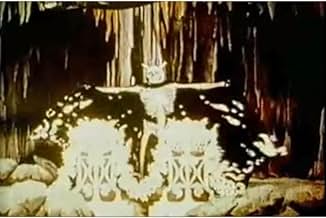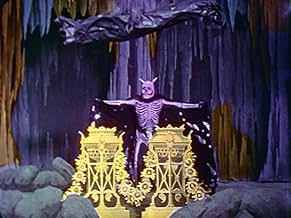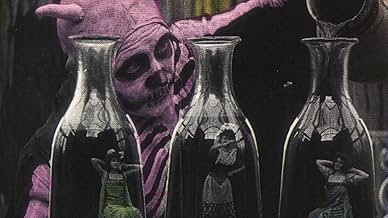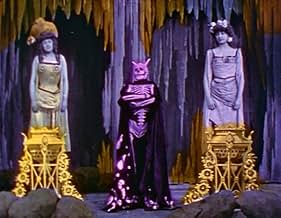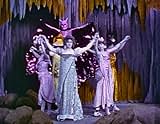IMDb RATING
6.5/10
1.3K
YOUR RATING
A demonic magician attempts to perform his act in a strange grotto, but is confronted by a Good Spirit who opposes him.A demonic magician attempts to perform his act in a strange grotto, but is confronted by a Good Spirit who opposes him.A demonic magician attempts to perform his act in a strange grotto, but is confronted by a Good Spirit who opposes him.
Featured reviews
The Red Spectre is a trick film from France in the style of Georges Méliès; although this one was directed by Ferdinand Zecca. It has all of the visual invention you would expect and it also has a nice red coloured tint which is perfect for its atmosphere.
It's set in an underground cavern and features a demon warlock. This evil character possesses souls of several women. He manipulates them in several ways and generates television-like screens. All the while he is counterbalanced by a female nemesis that thwarts his evil actions and ultimately destroys him.
It may be a short film but it's full to the brim with visual ideas. Characters appear and disappear, are shrunken and burst into flames. Walls are constructed and turn into giant monitors and rock faces move aside to show a cavern full of hell-like fires. It's relentlessly inventive basically. Worth seeing if you like the visual innovation of the earliest days of cinema.
It's set in an underground cavern and features a demon warlock. This evil character possesses souls of several women. He manipulates them in several ways and generates television-like screens. All the while he is counterbalanced by a female nemesis that thwarts his evil actions and ultimately destroys him.
It may be a short film but it's full to the brim with visual ideas. Characters appear and disappear, are shrunken and burst into flames. Walls are constructed and turn into giant monitors and rock faces move aside to show a cavern full of hell-like fires. It's relentlessly inventive basically. Worth seeing if you like the visual innovation of the earliest days of cinema.
In the late 19th and early 20th century, Georges Méliès was a very successful filmmaker. Much of it was because Méliès was originally a stage magician and he thought like one when making films. As a result, many of his films look like magic shows and the director used a lot of camera tricks to make things seemingly appear and disappear. Soon, others began copying his films....and among them, the Spaniard, Segundo de Chomón, was among the best....though his versions of the great master's films often were second-rate in quality.
"Le Spectre Rouge" is one of the best Chomón films to watch. This is because he crams every sort of camera trick into the film plus it's all in the form of a magic show. And, to get it all there, the film is about 9 minutes in length....which is amazingly long when the average movie was about one to two minutes long! As a result, you get a great homage to Méliès...one where you can see a lot of film footage showing his techniques which Chomón copied. This footage is all in the form of a weird caped skeleton-demon performing magic tricks until the tables are turned on him.
As far as how watchable all this is, it depends on you. If you love very, very early films by all means watch. Otherwise, you might find it tough going even if the film is technically brilliant.
"Le Spectre Rouge" is one of the best Chomón films to watch. This is because he crams every sort of camera trick into the film plus it's all in the form of a magic show. And, to get it all there, the film is about 9 minutes in length....which is amazingly long when the average movie was about one to two minutes long! As a result, you get a great homage to Méliès...one where you can see a lot of film footage showing his techniques which Chomón copied. This footage is all in the form of a weird caped skeleton-demon performing magic tricks until the tables are turned on him.
As far as how watchable all this is, it depends on you. If you love very, very early films by all means watch. Otherwise, you might find it tough going even if the film is technically brilliant.
Here's Segundo de Chomon challenging Melies as the master of the trick film, using the sort of magician's act that Melies did. It's a combination of stage magic and movie magic -- if you look carefully, you can see the moments when the camera stops and something is substituted.
Because whenever Melies got before the cameras and did his act -- he was a stage magician and had gotten into making movies to fill up the show at his Theatre Robert-Houdin -- you could see his pleasure in performing, there was no way that de Chomon could match that. So he stuck his unnamed performing in a skeleton costume with horns and a cape. It's so over-the-top that it's magnificent.
Because whenever Melies got before the cameras and did his act -- he was a stage magician and had gotten into making movies to fill up the show at his Theatre Robert-Houdin -- you could see his pleasure in performing, there was no way that de Chomon could match that. So he stuck his unnamed performing in a skeleton costume with horns and a cape. It's so over-the-top that it's magnificent.
If you've seen any of Georges Melies films there probably isn't anything here that you haven't seen before and, apart from one brief sequence, this film is pretty dull as a result.
The film takes place in an underground cavern where a skeletal demon amuses himself by conjuring up a couple of hypnotised girls whom he wraps in plastic sheet before levitating them. The sheets burst into flames as they hover before the demon makes them disappear. A good spirit then appears to repeatedly spoil the demon's fun. This goes on for the best part of ten minutes and, to be honest, it gets a little tedious after a while.
The one good sequence comes when the demon places three jars on a table then carries the table towards the camera. It's an unusual shot for 1907 and is quite effective - as is the demon's make-up.
The film takes place in an underground cavern where a skeletal demon amuses himself by conjuring up a couple of hypnotised girls whom he wraps in plastic sheet before levitating them. The sheets burst into flames as they hover before the demon makes them disappear. A good spirit then appears to repeatedly spoil the demon's fun. This goes on for the best part of ten minutes and, to be honest, it gets a little tedious after a while.
The one good sequence comes when the demon places three jars on a table then carries the table towards the camera. It's an unusual shot for 1907 and is quite effective - as is the demon's make-up.
Director Segundo de Chomon's THE RED SPECTRE is a wonderful, subterranean magic show, put on by the skeletal entity of the title. It features various female subjects in various tricks and fantastical situations.
Mr. De Chomon once again shows his sense of humor, along with his love of the supernatural. The special effects are, as always, some of the best of the era. Of special interest are the women in the bottles, the flip-screen images, and the reverse-action wall-building sequences.
Horror fans should find this short film fascinating, since it is one of the vintage examples of what was yet to come...
Mr. De Chomon once again shows his sense of humor, along with his love of the supernatural. The special effects are, as always, some of the best of the era. Of special interest are the women in the bottles, the flip-screen images, and the reverse-action wall-building sequences.
Horror fans should find this short film fascinating, since it is one of the vintage examples of what was yet to come...
Did you know
- TriviaHas a link to the Ulli Lommel's Zodiac Killer (2005) case. A letter allegedly sent by the Zodiac Killer, who may have been a film buff, was signed "The Red Phantom" and could have referred to this film or to the color "Masque of the Red Death" sequence in Lon Chaney's 1925 Le Fantôme de l'opéra (1925).
- ConnectionsFeatured in Hollywood (1980)
Details
- Release date
- Country of origin
- Languages
- Also known as
- The Red Spectre
- Production company
- See more company credits at IMDbPro
- Runtime9 minutes
- Color
- Sound mix
- Aspect ratio
- 1.33 : 1
Contribute to this page
Suggest an edit or add missing content


